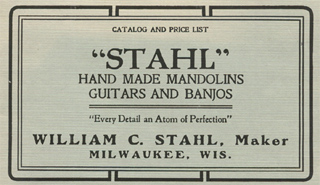|
Larson guitar building characteristics:
there are a number of characteristics that indicate
the origin of a Larsons made guitar:
1. The Larson fretboard is always ebony and thicker than most. If
bound, a stripe of black fretboard wood is visible under the fretboard
binding, when viewed from the side, as in the following photo.....and
photo
2.the bridge is a characteristic "flattened pyramid",
a style also used extensively by Lyon and Healy (Washburn) and other
makers as well.
3. The top and back are slightly, but visibly arched, not flat,
producing the deepest measurement in the center of the guitars body
. See photo....
4. On 12 fret to the body guitars, the Larsons almost always marked
the 10th fret instead of the ninth, as done by most other makers.
5. Inlays and bindings share characteristics if not exact details.
see photo.....
6. The binding around the lip of the soundhole has a wooden ledge
that it sits on , visible under the ring of binding, when viewed
from a side perspective.
7.Only guitars by the Larsons have the rod and/or tube, characteristic
of the prairie state instruments, occasionally found on guitars
with other Larson imprints, but never found on any other makers
instruments. see photo....
|
|
Bracing:
The Larsons experimented with bracing patterns
to some extent.
Most guitars are x braced in a manner similar but not identical
to the martin system. The Larsons often employed laminated braces
for additional strength. As in all their work, there is a capricious
willingness to experiment that surprisingly resulted in instruments
that are remarkably consistent in sound.
The Larsons sometimes utilized a ladder style of bracing on their
lower end instruments that is significantly different from that
of other makers. Instead of the usual 3 large clumsy braces found
in many inexpensive guitars, the Larsons used 4,5,or 6 slender lateral
braces that restrict the movement of the top to a lesser degree..
We have a small pearl trimmed rosewood guitar with ladder braces
and it sounds quite lovely.
|
|
Materials:
We have seen back and sides made of oak, mahogany,
hawaiian koa, maple, and rosewood, all in association with spruce
tops and ebony fretboards and bridges, even on the least expensive
models. The quality of the woods are quite exceptional in
all cases. It is a mistake to dismiss lower end Larson guitars as
unworthy of appreciation. I have a bottom of the line oak guitar
that is lovely..and made with exceptionally fine, quarter sawn oak
...
|
|
Maurer size chart:
The 1932 Maurer/Prairie State Catalog lists the following
dimensions for their 12 fret to the body models.
|
| Model |
Body Length |
Width @ Bridge |
Scale Length |
| Standard Size |
18" |
12 3/4" |
24 5?8" |
| Concert Size |
18 7/8" |
13 1/2" |
25" |
| Grand Size |
19 1/8" |
14" |
25 3/8" |
| Auditorium Size |
20" |
15" |
25 5/8" |
|
The labels:
The Larson name has not been well known to the
general, guitar buying public. They manufactured a fair number of
instruments from 1900 till 1944 with no manufacturers' imprint at
all. They manufactured instruments under a wide variety of names,
many of which referred to the distributor or store that ordered
them.
Here is a list of names we have encountered on Larson made instruments.
Many of these makers imprints can be found on instruments not made
by the Larsons....some of them were always Larson made instruments,
as noted.
|
|
Always manufactured by the Larsons:
Euphonon
Prairie State
Maurer ( Any instrument after 1900)
|
|
Often manufactured by the Larsons:
WM. Stahl
Dyer
Stetson
|
|
Sometimes ( sometimes
rarely) manufactured by the Larsons:
Leland
Southern California Music Company
C.Bruno
H.F.Meyer
|
|
The larsons made a wide variety
of instruments.....
Guitars: flat top steel strings and (rarely) arch
top f hole guitars ( tops were not carved)
Harp guitars and related "harp mandolin family" instruments
Mandolins and other mandolin related instruments i.e.
Mandocello
Mandobass
Ukulele
Tiple
Anybody ever seen a Larson made 12 string????
The variety of instruments the Larsons produced
is impressive, considering that there were only two guys, and the
overall build quality of the instruments is exceptional. Even within
the category of 6 string flat tops, they produced an astounding
variety of styles, sizes and ornamentation. They made guitars that
seem small ( sometimes tiny) by today's standards, and guitars notably
larger than a j200 or super 400.
Estimates of the Larsons total output varies.
High side figures are based on one instrument per day and a total
of 10,000 -12,000 instruments. My own guesstimate is substantially
lower. Based on inquiries of major dealers as to numbers of Larsons
; D'angelico's and Sunburst Les pauls to have passed through their
hands,as well as inquiries of currently active luthiers, I believe
the total number of Larson instruments( of all types) is closer
to 2500 and no more than 3500 instruments of all types.
The Larson guitars I've played have consistently had exceptionally
detailed and filigreed voices. They have a richness of harmonic
content that is notably different than any other manufacturer. Singing,
with a sweet and shimmering tonality. They also exhibit outstanding
power and clarity . They have a balance of sound from low to high
strings that is rarely encountered in other makers' instruments.
When properly set up, they play wonderfully. Sometimes refered
to as "fingerpicking" guitars, they actually respond as
well to a pick . Ive found them to be great recording instruments,and
they perform as well for "rock/pop" power chord flat picking,
as they do arpeggioed single note work. In any case, they sound
great and microphones love them.
Check out this Stahl catalog......click on it to open the pages....
|
 |
|
|